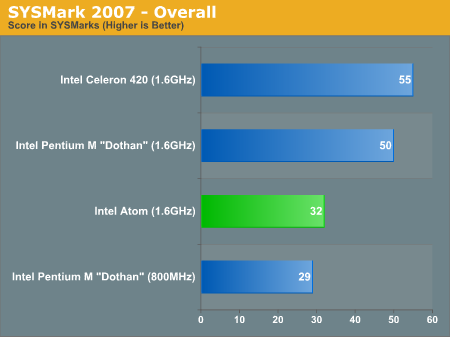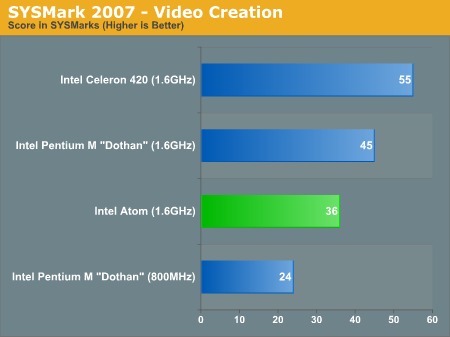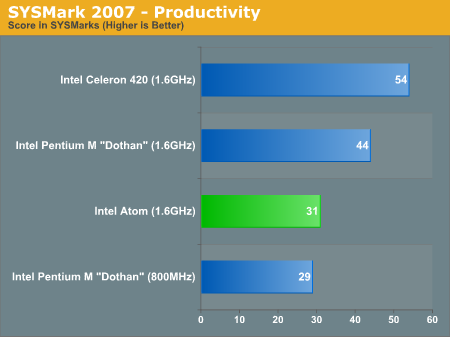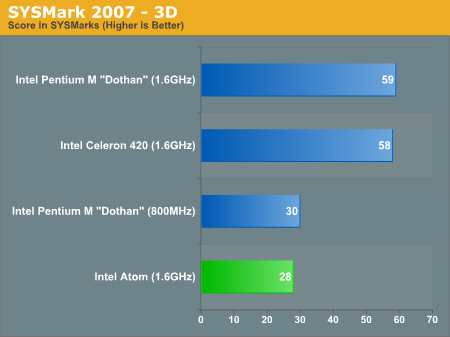ASUS Eee Box Preview & Intel's Atom Benchmarked
by Anand Lal Shimpi on June 3, 2008 12:00 AM EST- Posted in
- Systems
If you aren't familiar with Intel's Atom processor be sure to read our piece on its architecture.
| CPU-Z Latency Test | L1 Cache | L2 Cache | Memory |
| Intel Atom (1.6GHz) | 3 cycles | 18 cycles | 129 cycles |
| Intel Celeron 420 (1.6GHz) | 3 cycles | 14 cycles | 125 cycles |
| Intel Pentium M "Dothan" (1.6GHz) | 3 cycles | 10 cycles | 172 cycles |
Atom has the same 3 cycle L1 access latency of even the modern Celeron 420, but its L2 cache latency is almost 30% greater than Conroe's, not to mention almost double that of the original Pentium M. Atom's L2 cache is far more power efficient than either core we're comparing to here so the sacrifice in performance is not unexpected.
Memory access latency is comparable to the Celeron 420 thanks to the modern memory controller in the Intel 945G chipset, unfortunately Atom needs lower latency memory accesses since it is an in-order CPU. The follow-on to Atom, codenamed Moorestown will address this problem but it won't be until 2009/2010 before we see that.
We started with a full run of SYSMark 2007 to show how the Atom stacks up in the same CPU heavy workload that we subject all desktop CPUs to:

The first result sets our expectations: a 1.6GHz Atom is around 10% faster than an 800MHz Pentium M. Early data Intel shared with us indicated that the 1.6GHz Atom should be around 20% faster than an 800MHz Dothan, so we're within the realm of reasonable here. Compared to the cheapest single-core desktop CPU Intel is shipping today, the Atom offers around 60% of its performance.

The E-Learning suite has the 800MHz Dothan just edging out the Atom in performance and interestingly enough, the 1.6GHz Dothan actually takes the lead here. With a large 2MB L2 cache the Dothan is at an advantage compared to both the Celeron 420 and the Atom.

The video creation suite has the Atom outperforming the 800MHz Dothan by 50%, which is quite impressive given the Atom's significantly simpler microarchitecture. Clock for clock Dothan is still 25% faster than the Atom but its performance is quite competitive here.

These last two benchmarks show the Atom at 1.6GHz about on par with the 800MHz Dothan.











35 Comments
View All Comments
mauriceh - Monday, September 15, 2008 - link
I am at a ASUS dealer in Canada.So far all we have had available is the model with XP , 80Gb, 1GB RAM.
DEALER Wholesale on this unit is $349, and there is a kickback of $20 a unit if you buy 100 pieces.
Further ASUS can not tell us of ANY ETA for the Linux model.
It looks VERY much like M$ are throwing some weight against this.
yuhong - Sunday, June 15, 2008 - link
I wonder exactly what was the bottleneck that made Vista feel so slow on this system.Rza79 - Tuesday, June 3, 2008 - link
It would have been great if you would have included results without Hyperthreading. Then i can get a better understanding in how the Atom performs in single threaded applications and how efficient Hyperthreading is.It would be meaningful to include a Via C7 1.6Ghz because then i could know how the Atom performs compared to the C7 (and Nano since Via released comparisons between them).
hermunn - Tuesday, June 3, 2008 - link
I miss having a Linux / FreeBSD computer on my own, and I really want something like the EeeBox. I will use it for text editing (emacs + LaTeX), web and email. My girlfriend hogs my old TiBook, and I would love to restrict the use of Windows as much as possible. My current employer (college) use Office and has supplied me with a Windows XP computer. I do not enjoy it. A Linux computer will allow me to do research (emacs + LaTeX for the win) in a safe environment. It will also be the base configuration for my small (tiny) programming projects.Why something like an EeeBox? First of all, I want a Linux box that is quiet and cheap, and the EeeBox is more then powerful enough for my needs (LaTeX, web, email, Singular, ..). I will buy an EeeBox if they manage to make the final version quiet, and nothing clearly better is available.
I imagine a small but significant number of geeks who see one and two uses for the EeeBox as a third or fourth computer, and a horde of computer literates who see the EeeBox as a nice first Linux computer. The hardware is designed to be 100% compatible with Linux, and the distribution will be focused on usability. A less steep learning curve than most other ways into the Linux world.
pmonti80 - Tuesday, June 3, 2008 - link
Anand you say that EEE Box can't play better than 720p at 4.5mbps but wich codec where you using?. Core AVC codec is know to be very efficient and it would be interesting to know if buying this codec would be enough to make Atom a CPU to watch HD content.pmonti80 - Tuesday, June 3, 2008 - link
A benchmark of a 1.6Ghz VIA C7 would be interesting too.JimmiG - Tuesday, June 3, 2008 - link
I could easily find a third PC useful. I would set it up in the kitchen or living room or another convenient location, with a ~15" LCD and compact mouse and keyboard. It would be used for email, web browsing and maybe music (a simple analog cable to the amplifier aux in would be enough for me). However the next generation EeePC would also fill this function while taking up less space and being portable. Another option is the very stylish, but still somewhat overpriced (for the specs), Mac Mini. I think the Eee Box can be thought of as a cheaper Mini.With wireless networking, I could make the any one of those little machines access e.g. my mp3 or photo collection from the main rig.
For it to be useful, there are some requirements:
1. Fast boot times - if it takes minutes to boot, I might as well walk to my main PC or borrow my gf's.
2. Near-silent operation. One reason to use such a PC instead of my main rig when just browsing the net etc. would be noise levels. My main PC is not extremely noisy, but it's far from silent. I'd prefer a passively cooled mini-pc with a 16GB or bigger solid state drive, to be able to lazily browse the web in peace and quiet.
3. It needs wireless networking that works out of the box. It needs to be able to detect and use anything I might think of plugging into it, like cameras, mp3 players, input peripherals, printers (also networked) etc. There needs to be support for all the video formats and web functionality, and programs preinstalled for all common tasks.. and so on. It shouldn't feel like I'm using a PC.. It should be like using any other piece of consumer electronics.. turn it on and start using it.
In my experience, MacOS is most likely to accomplish this, followed by Linux, then XP/Vista. XP is pretty "bare bones" when it comes to such functionality, requiring drivers and third party apps to do anything useful.. Vista Basic isn't much better. Linux distros tend to come bundled with pretty much everything you need. But the OS also needs to be "polished" and "work".. Not like the latest version of Ubuntu for example.. Very user friendly and polished.. until it was time to try and get online using my USB wlan dongle...no amount of friendly dialog boxes or big helpfiles would allow me get online... How useful is a computer if you can't even get online? It was the usual Linux routine of reading "howto's" and forums, then entering cryptic commands and editing textfiles, most of the time not understanding a thing of what you're doing. For the hobbyist, that's OK - but on a PC bordering on “consumer electronics”, it's not acceptable and it's Linux distro needs to be more polished and refined than that.
Truxy - Tuesday, June 3, 2008 - link
A small office of 25 PCs I consult for has been waiting for something just like this to come along for a while now. There's a room so small that is intermittantly used all day, with 3 full sized PCs that take up too much of the available space and cause way too much heat. We dabbled in using some shuttle PCs but it didn't work out (power supplies were blowing too often).I'll be ordering two to test drive ASAP and hopefully order more soon after.
ATWindsor - Tuesday, June 3, 2008 - link
I guess this is a pretty stupid question, but how does the monitor-mount work? Does one have to remove sthe existing foot of the monitor? Or can one just attach the computer on the back of a normal monitor?And to bad its not fanless.
autoboy - Tuesday, June 3, 2008 - link
I'm still waiting on the results for mpeg2 1080i decoding...The 945 has hardware acceleration for mpeg2 (VLD + iDCT + MC) so it should be more capable as a slim player for people who use mpeg2 more often than h.264. I use an HDHR to record my programs and an R5000 so everything is in mpeg2 720p or 1080i (or 480i SD but we know that works fine. Any chance we can add that to the benchmarks?